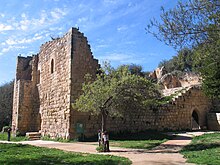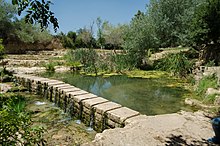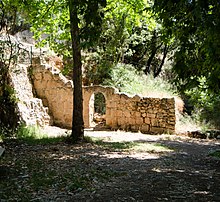Ein Hemed
עין חמד or Aqua Bella | |
 | |
| Location | Jerusalem area, Israel |
|---|---|
| History | |
| Builder | Hospitaller Order |
| Periods | Crusader period, middle ages |
| Cultures | Crusader |
Ein Hemed is a national park and nature reserve in the hills seven kilometres west of modern



Name
The Crusaders named it "Aqua Bella" in Latin,[4] a name which was corrupted in Arabic to Iqbalā, thus becoming Khirbet Iqbalā, "Iqbalā Ruins".[5] The 19th-century Arabic name was Deir el-Benat, also spelled Dayr al-Banat, "convent of the maidens"[6] and "Khurbet Ikbala", interpreted at the time to mean "The ruin of prosperity"; perhaps "the southern ruin",[7] or "the ruin opposite."[8]
History
Crusader courtyard building

The
Impressive ruins of a 30x40 metre Crusader courtyard building, whose southern wall survives to a height of 12 metres, are located on the north site of the riverbed. The building has several gates and two arched halls. Archaeological investigations indicate that it was built in 1140-1160, during the reign of
Mandate period
The castle is shown as Khirbat Iqbalā on the 1880 PEF Survey of Palestine map, and as El Burj ("The Tower)" on the 1940s Survey of Palestine map.
The of Ein Hemed was historically on the village lands of
Nachalat Yitzchak
In 1925, an American Jew named Isaac Segal Feller purchased a plot of 600

National park and nature reserve
The nature reserve and park were established in 1968.[11] The cemetery includes the grave of Sheikh Abdullah, in whose honour the oak and terebinth trees in the nature reserve were never cut down. A picnic site has been created nearby. Four layer springs issue from the riverbed and nearby caves, and unite into a flow of water which continues for about 400 metre. Several dams have been built, creating pools, the largest of which is 20 x 20 metres and 1 metre deep.[12]
See also
- Tourism in Israel
- National Parks of Israel
References
- ^ S2CID 162314029. Retrieved 20 June 2020.
- ^ Latest Wrinkle in Israeli Tourism: Bat-spotting
- S2CID 162314029.
- ^ Pringle, 1993, p. 239
- ISBN 9780826480675. Retrieved 20 June 2020.
- ^ Palmer, 1881, p. 293
- ^ Palmer, 1881, p. 306
- ^ Clermont-Ganneau, 1896, ARP2, p. 57
- ^ פסק-דין בתיק עש 2013/03
- ^ עברייני נדל"ן ודיירים מסתוריים: הכירו את שכונת הרפאים בעין חמד
- ^ "List of National Parks and Nature Reserves" (PDF) (in Hebrew). Israel Nature and Parks Authority. Archived from the original (PDF) on 2009-10-07. Retrieved 2010-09-27.
- ^ "Ein Hemed National Park". Archived from the original on 2009-06-27. Retrieved 2009-07-21.

Bibliography
- Avner, Rina (2009-07-15). "'En Hemed" (121). Hadashot Arkheologiyot – Excavations and Surveys in Israel.
{{cite journal}}: Cite journal requires|journal=(help) - Clermont-Ganneau, C.S. (1899). [ARP] Archaeological Researches in Palestine 1873-1874, translated from the French by J. McFarlane. Vol. 1. London: Palestine Exploration Fund. (p. 22)
- Clermont-Ganneau, C.S. (1896). [ARP] Archaeological Researches in Palestine 1873-1874, translated from the French by J. McFarlane. Vol. 2. London: Palestine Exploration Fund.
- Conder, C.R.; Kitchener, H.H. (1883). The Survey of Western Palestine: Memoirs of the Topography, Orography, Hydrography, and Archaeology. Vol. 3. London: Committee of the Palestine Exploration Fund. (pp. 114−115; 165)
- Guérin, V. (1868). Description Géographique Historique et Archéologique de la Palestine (in French). Vol. 1: Judee, pt. 1. Paris: L'Imprimerie Nationale. (pp. 278−279)
- Palmer, E.H. (1881). The Survey of Western Palestine: Arabic and English Name Lists Collected During the Survey by Lieutenants Conder and Kitchener, R. E. Transliterated and Explained by E.H. Palmer. Committee of the Palestine Exploration Fund.
- )
- ISBN 978-0-521-85148-0. (p. 267)
- Röhricht, R. (1893). (RRH) Regesta regni Hierosolymitani (MXCVII-MCCXCI) (in Latin). Berlin: Libraria Academica Wageriana. (p. 51, No 205)
- Storchan, Benyamin (2015-12-15). "'En Hemed, Hemed Interchange" (127). Hadashot Arkheologiyot – Excavations and Surveys in Israel.
{{cite journal}}: Cite journal requires|journal=(help) - Tyrwhitt-Drake, C.F. (1874). "Mr. Tyrwhitt-Drakes Reports". Quarterly Statement - Palestine Exploration Fund. 23: 64–79. (p. 77)
- Zilberbod, Irina (2016-06-26). "'En Hemed" (128). Hadashot Arkheologiyot – Excavations and Surveys in Israel.
{{cite journal}}: Cite journal requires|journal=(help)
External links
- Survey of Western Palestine, Map 17: IAA, Wikimedia commons


